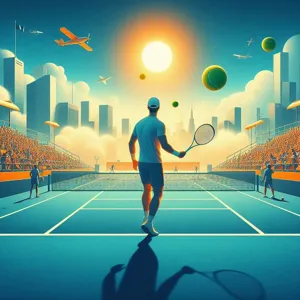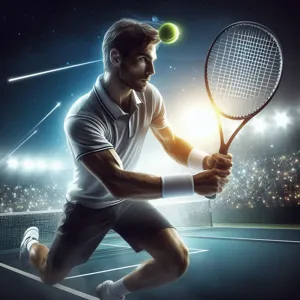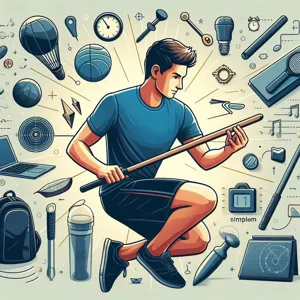Tennis is not just a game of physical prowess; it’s a dynamic blend of strategy, agility, and mental fortitude.
Whether you’re a beginner eager to improve your skills or an experienced player looking to refine your technique, mastering the court requires more than just mastering your serve or perfecting your forehand. In this blog post, we’ll delve into strategic techniques that can elevate your tennis game to new heights. From understanding the nuances of court positioning and shot selection to developing a winning mindset, our comprehensive guide will equip you with the tools you need to outsmart your opponents and enhance your performance. Get ready to unlock your potential and transform your play with insights that will have you dominating the court in no time!
1. Understanding the Fundamentals of Tennis Strategy

To truly master the court, a solid grasp of the fundamentals of tennis strategy is essential. While the technical aspects of your game—such as your serve, forehand, and footwork—are crucial, understanding how to apply these skills in a strategic context can set you apart from your competitors. Start by familiarizing yourself with the different types of shots and when to use them. For instance, a well-placed drop shot can be an effective tool to catch your opponent off guard, while a powerful baseline rally can wear them down over time.
Additionally, consider the court’s dimensions and how they influence your positioning. Are you playing on clay, which typically favors longer rallies, or on grass, where quick volleys and faster points are the norm? Knowing the surface can help you adapt your strategy to exploit your opponent’s weaknesses.
Another fundamental aspect is the importance of shot selection. Rather than blindly hitting the ball, think critically about your next move. Are you in a defensive position, or do you have the upper hand? This awareness will help you choose shots that maximize your chances of winning the point.
Moreover, always keep an eye on your opponent. Pay attention to their strengths and weaknesses, and adjust your game plan accordingly. Are they uncomfortable with high balls? Do they struggle with backhand returns? Use this knowledge to dictate the pace and direction of the match, forcing them into positions where they are less effective.
Incorporating these foundational strategic elements into your game not only enhances your performance but also builds your confidence on the court. As you become more adept at recognizing patterns and making strategic decisions, you’ll find that your tennis game will not only improve, but you’ll also enjoy the sport more deeply, relishing the thrill of outsmarting your opponent with each point played.
2. The Importance of Court Positioning
Court positioning is a fundamental aspect of tennis that can significantly influence your performance and strategy on the court. Whether you’re a beginner or a seasoned player, understanding where to stand and how to move can be the difference between a winning shot and a missed opportunity.
Imagine the court as a dynamic chessboard, where every move counts. By mastering your positioning, you not only enhance your ability to anticipate your opponent’s shots but also improve your own shot selection. For instance, positioning yourself closer to the net allows for aggressive volleys and quick reactions to high balls, while retreating to the baseline provides you with the time and space needed to execute powerful groundstrokes.
The key lies in being adaptable. As the ball travels, your positioning should shift accordingly—moving forward to cut off angles or stepping back to give yourself time to prepare for a deep shot. A well-placed shot can create opportunities to control the rally, forcing your opponent into a defensive position. Conversely, being caught flat-footed or out of position can lead to weak returns and easy points for your opponent.
Moreover, maintaining an optimal court position allows you to conserve energy. By positioning yourself strategically, you can minimize unnecessary movements and maximize efficiency, allowing you to remain agile and ready for whatever comes your way.
Incorporating drills that focus on footwork and court awareness into your practice routine can foster a deeper understanding of positioning. Visualization techniques can also help, allowing you to mentally rehearse your movements in various match scenarios.
Ultimately, mastering court positioning empowers you to dictate the flow of the game, increases your confidence, and can lead to more consistent performance. By focusing on where you stand, you’ll not only elevate your game but also become a more formidable competitor on the court.
3. Analyzing Your Opponent’s Weaknesses

Analyzing your opponent’s weaknesses is a critical strategy that can significantly elevate your tennis game and give you a competitive edge on the court. Every player has areas where they struggle, whether it’s a weak backhand, difficulty with high balls, or a tendency to falter under pressure. By identifying these vulnerabilities, you can tailor your game plan to exploit them effectively.
Start by observing your opponent during warm-ups and early rallies. Pay attention to their shot selection, footwork, and overall demeanor. Are they favoring one side? Do they seem uncomfortable when receiving serves? Take mental notes of these patterns, as they can provide valuable insights into how to craft your strategy.
As the match progresses, remain vigilant and adaptable. If you notice your opponent consistently mishitting backhands, focus your shots toward that side. Use placement and angles to draw them out of position, forcing errors or weak returns. Additionally, consider mixing up your pace and spin to disrupt their rhythm—this can be particularly effective against players who thrive on consistency.
Moreover, don’t underestimate the psychological aspect of the game. If you can expose your opponent’s weaknesses early, you may instill doubt and increase the likelihood of unforced errors. Remember, tennis is as much a mental battle as it is a physical one. By analyzing and exploiting weaknesses, you not only improve your chances of winning but also enhance your overall strategic thinking on the court.
In summary, take the time to study your opponent, adjust your tactics accordingly, and maintain a flexible mindset. With practice, this analytical approach will become second nature, transforming you into a more strategic and formidable player.
4. Developing a Strong Serve: Techniques and Tips
A strong serve is often the cornerstone of a successful tennis game, setting the tone for each point and giving you a significant strategic advantage. Mastering this fundamental skill requires not only physical strength but also finesse and precision. Here are several techniques and tips to help you develop a powerful and effective serve that can elevate your overall performance on the court.
**1. Grip Matters:** Start with the right grip. The most commonly used grips for serving are the Continental grip and the Eastern grip. The Continental grip is favored by many professionals as it allows for versatility, enabling you to hit both flat serves and spin serves with ease. Experiment with both grips to see which feels most comfortable and provides the control you need.
**2. Stance and Positioning:** Your stance plays a crucial role in your serve. Stand with your feet shoulder-width apart, positioning your non-dominant foot slightly ahead of the other. This athletic stance not only provides balance but also prepares your body for a powerful rotation during the serve. Remember to angle your body sideways to the net, allowing for a more powerful hip and shoulder rotation.
**3. Toss with Precision:** A consistent toss can make or break your serve. Aim to toss the ball in front of you, slightly to the side, and at a height that allows you to strike it at the peak of your reach. Practice your toss separately—closing your eyes can help you focus solely on the ball’s position without getting distracted by other elements on the court.
**4. Engage Your Core:** Generating power in your serve comes not just from your arm, but from your entire body. Engage your core muscles as you prepare to serve. As you toss the ball, rotate your hips and shoulders, allowing that energy to transfer through your arm and into the racket. This full-body movement creates a more explosive serve and reduces the risk of injury.
**5. Follow Through:** Don’t underestimate the importance of a proper follow-through. After making contact with the ball, your racket should continue its motion, finishing high above your opposite shoulder. This ensures that you’re not only hitting the ball with power but also with accuracy, allowing for better placement.
**6. Practice Different Serves:** Incorporate variety into your serving practice. Work on flat serves for speed, slice serves for spin, and kick serves for unpredictability. Each type of serve can keep your opponent guessing and off-balance. Regularly practicing these different techniques will enhance your overall serve repertoire.
Incorporating these strategic techniques into your training regimen can significantly improve your serve, making it a weapon that not only secures points but also instills confidence in your game. Remember, consistency is key, so dedicate time to practice and refine your serving skills, and watch as your performance on the court begins to soar.
5. The Art of Rallying: Consistency vs. Aggression

Mastering the art of rallying is a fundamental skill that can significantly impact your performance on the court. At its core, rallying is about finding the delicate balance between consistency and aggression—a dance of strategy that can dictate the flow of the game.
Consistency is your safety net. It involves keeping the ball in play, maintaining the rhythm, and forcing your opponent to make mistakes. A consistent player meticulously places shots, focusing on depth and placement rather than power. This approach can frustrate aggressive opponents who thrive on quick points. By employing consistent rallying, you can outlast your opponent, wearing them down until they make an unforced error or provide you with an opportunity to seize control of the point.
On the other hand, aggression is about seizing the initiative. An aggressive player looks for openings to attack, aiming to dictate the pace of the match with powerful groundstrokes, sharp angles, and strategic volleys. While this approach can lead to quick points, it requires a keen sense of timing and the ability to read your opponent’s movements. The key to successful aggression is knowing when to strike; being too eager can lead to mistakes and a loss of momentum.
To truly master rallying, assess your own strengths and weaknesses as well as those of your opponent. Are they prone to errors under pressure? If so, play a consistent game to exploit their weaknesses. Conversely, if they struggle to respond to aggressive play, don’t hesitate to unleash your shots and take control.
The beauty of tennis lies in its strategic depth. By understanding when to rally with consistency and when to adopt an aggressive stance, you can elevate your game, keep your opponents guessing, and ultimately, master the court. Practice this balance during training sessions, experimenting with different styles and strategies to discover what works best for you. With time and experience, you’ll find that the art of rallying becomes second nature, leading to a more dynamic and effective game.
6. Effective Shot Selection: When to Use Each Stroke
Effective shot selection is a cornerstone of elevating your tennis game and mastering the court. Understanding when to deploy each stroke can not only enhance your performance but also outsmart your opponents. In every match, the ability to read the game and anticipate your opponent’s next move is crucial.
First and foremost, it’s essential to know your strokes inside-out. The forehand is often considered your “go-to” shot. It’s powerful and versatile, ideal for aggressive baseline play. Utilize it when you’re in a position to attack and push your opponent back, creating space for a follow-up shot. Conversely, the backhand can be a defensive tool, particularly useful when you’re stretched wide to retrieve a tough shot. A strong two-handed backhand can generate both depth and spin, giving you a tactical advantage.
When it comes to net play, mastering volleys becomes key. These shots require quick reflexes and decisive movement. A well-timed volley can put immense pressure on your opponent, forcing them into errors or weak returns. Similarly, the overhead smash is a potent weapon when your opponent lobs the ball over you. Positioning yourself correctly and maintaining focus will enable you to execute this shot effectively, often ending the point decisively.
Moreover, recognize the value of strategic dropshots and slices. A drop shot can catch an opponent off guard, particularly after a series of deep rallies, while slices are perfect for disrupting rhythm and changing the pace of the game. By varying your shot selection, you’ll keep your opponent guessing, making it harder for them to settle into a predictable rhythm.
In conclusion, effective shot selection is about more than just executing perfect strokes—it’s about understanding when and how to use them. By mastering this aspect of your game, you’ll not only elevate your performance on the court but also gain a competitive edge that can lead to victory. Continually assess your options, adapt to your opponent’s style, and remember: the right shot at the right moment can change the course of any match.
7. Mastering the Volley: Techniques for Net Play

Mastering the volley is an essential skill that can significantly elevate your tennis game, transforming your presence at the net from passive to aggressive. As you approach the net, your stance and positioning become crucial. Stand with your feet shoulder-width apart, knees slightly bent, and weight balanced on the balls of your feet to allow for quick lateral movements. This athletic posture not only prepares you for incoming shots but also exudes confidence to your opponent.
When it comes to executing the volley, focus on your grip. A continental grip is often preferred, as it provides versatility for both forehand and backhand volleys. As the ball approaches, keep your racket head slightly above the grip and prepare to make contact in front of your body. This positioning allows for better control and precision, enabling you to direct your volleys with purpose—whether you’re aiming for a sharp angle or a deep shot toward the baseline.
Timing is another critical component of mastering the volley. Wait for the ball to drop to a comfortable height before making your move; this will help you avoid mishits and ensure a cleaner strike. Practice your footwork to close the distance between you and the ball quickly, allowing you to intercept shots early and take control of the point.
Additionally, employ the “punch” technique rather than swinging your racket like you would for a groundstroke. A firm and stable motion will help maintain control and generate the necessary power while minimizing the risk of errors. Remember to follow through with your racket, directing your shot toward your target, and be ready to react to your opponent’s response.
Finally, don’t underestimate the mental aspect of net play. Anticipate your opponent’s shots and remain alert, as volleying often requires quick reflexes and strategic thinking. By mastering the volley, you can dictate the pace of the game, put pressure on your opponent, and create opportunities for winning points. With practice, your net play will not only improve but also become a formidable part of your overall strategy on the court.
8. Utilizing Spin to Gain an Advantage
When it comes to elevating your tennis game, mastering the art of spin can be a game-changer. Spin isn’t just a flashy technique; it’s a strategic tool that can help you gain a significant advantage over your opponents. By incorporating topspin, backspin, and sidespin into your shots, you can manipulate the ball’s behavior in ways that create opportunities and challenges for your rival on the court.
Topspin, for example, is your ally when it comes to consistency and control. By brushing up on the ball as you strike it, you propel the ball forward with a higher arc, allowing it to dip sharply as it approaches the opponent’s side. This makes it difficult for them to attack, as they will need to adjust their timing and positioning. Additionally, topspin shots tend to bounce higher, pushing your opponent back and giving you the upper hand in rallying.
On the flip side, backspin can be particularly effective when you want to disrupt your opponent’s rhythm. A well-executed slice shot, which employs backspin, can stay low after bouncing, making it challenging for your opponent to generate power on their return. This technique is particularly useful at the net, where a sudden change in pace can leave your opponent scrambling.
Then there’s sidespin, which is often underestimated. By imparting sidespin to your shots, you can create unpredictable angles that can send your opponent off-balance. This is especially effective on serves and groundstrokes, where the ball curves away or toward your opponent, forcing them to adjust their footwork and positioning.
Incorporating these spins into your gameplay not only enhances your shot variety but also keeps your opponents guessing. Remember, the key is to practice these techniques regularly to build muscle memory and confidence. The more proficient you become at utilizing spin, the more you’ll notice your opponents struggling to adapt, giving you the strategic edge you need to dominate the court. So, the next time you step onto the tennis court, think strategically about how you can spin your way to victory!
9. Mental Toughness: Staying Focused During Matches
In the high-stakes world of tennis, where every point counts and the pressure can be suffocating, mental toughness is often the differentiating factor between victory and defeat. Staying focused during matches isn’t just about physical prowess; it’s about cultivating a resilient mindset that allows you to perform under pressure.
One effective technique to enhance your mental toughness is visualization. Before stepping onto the court, take a few moments to mentally rehearse your game. Picture yourself executing your serves with precision, anticipating your opponent’s moves, and celebrating each point won. This mental imagery not only prepares you for the match ahead but also helps build your confidence, allowing you to approach the game with a positive mindset.
Additionally, incorporating mindfulness practices can significantly improve your focus during matches. Simple techniques such as deep breathing or staying present in the moment can help you shake off distractions and maintain concentration. For instance, when you feel your mind wandering or anxiety creeping in, take a deep breath, refocus your thoughts, and remind yourself of your game plan.
It’s also crucial to develop a routine before each point. This could include bouncing the ball a certain number of times before serving or taking a moment to reset your thoughts between points. Such rituals not only create a sense of familiarity and control but also serve as a mental anchor, helping you maintain focus amidst the ebb and flow of the match.
Lastly, remember that mental resilience is built over time. Embrace challenges as opportunities to grow, learn from your setbacks, and celebrate your progress. By fostering a strong mental game, you’ll not only improve your performance on the court but also develop a tenacity that can lead you to greater heights in your tennis journey. The path to mastering your game is as much a mental endeavor as it is a physical one, so cultivate that mental toughness, and watch your performance soar.
10. Creating a Game Plan: Preparing for Your Opponent
Creating a game plan is an essential strategy for any tennis player looking to elevate their game and gain the upper hand against their opponents. Preparation is not just about practicing your own strokes and footwork; it also involves understanding your opponent’s strengths, weaknesses, and playing style. Before stepping onto the court, take the time to analyze your competitor. Are they a powerful server with a strong forehand, or do they rely on finesse and placement? By observing their past matches, you can identify patterns in their play, such as their preferred shot selections and where they struggle under pressure.
Once you have a solid grasp of your opponent’s game, it’s time to craft your strategy. Depending on their style, you may want to exploit their weaknesses—targeting their backhand if it’s less reliable, or drawing them to the net if they seem uncomfortable in volley situations. On the other hand, if you’re up against a strong baseline player, consider implementing a more aggressive approach with well-placed serves and varied shots that keep them guessing.
Don’t forget to visualize your game plan. Mentally rehearsing your strategy can enhance your confidence and help you execute it more effectively during the match. As you play, remain flexible and ready to adjust your tactics based on how the match unfolds. Tennis is as much a mental game as it is a physical one, and having a well-thought-out plan can set you apart from the competition. With a strategic mindset and the willingness to adapt, you’ll not only improve your performance but also enjoy the game at a deeper level.
11. Adapting Your Strategy Mid-Match
In the fast-paced world of tennis, the ability to adapt your strategy mid-match can be the difference between victory and defeat. Every player steps onto the court with a game plan, but as the match unfolds, conditions change, and opponents reveal their strengths and weaknesses. The key to mastering the court lies in your responsiveness and flexibility.
First, take note of how your opponent plays. Are they consistently strong on their forehand but struggle with backhand shots? Do they have a preferred serve placement? By keenly observing these tendencies, you can adjust your shots to exploit their vulnerabilities. For instance, if you notice your opponent faltering on high balls, start incorporating more topspin into your game to keep them on the defensive.
Moreover, consider the physical and mental state of both yourself and your opponent. If you’re feeling fatigued, it might be wise to shorten your rallies and focus on precision rather than power. Conversely, if your opponent is visibly struggling, ramp up the pressure with aggressive serves and deep groundstrokes to capitalize on their weakness.
Another important aspect of adapting your strategy is changing your playing style mid-match. If you began with a baseline-heavy approach but find yourself being drawn into the net, consider employing more volleys and drop shots to mix up the pace and disrupt your opponent’s rhythm. Likewise, if you started aggressively but your opponent has adjusted, it may be time to play more defensively, allowing them to make mistakes.
Communication with your coach during breaks can also offer fresh insights. They might spot patterns you’ve overlooked or suggest strategic shifts that align with your strengths. Remember, adaptability is not just a skill; it’s a mindset. Embrace the unpredictability of the game, stay observant, and be willing to pivot. By mastering the art of mid-match strategy adaptation, you’ll not only elevate your own game but also outmaneuver your opponents, turning the tide in your favor as you strive for victory on the court.
12. Fitness and Conditioning for Optimal Performance
Fitness and conditioning play a crucial role in elevating your tennis game, transforming you from a casual player into a formidable competitor on the court. Tennis is not just a test of skill; it demands a unique blend of agility, strength, endurance, and flexibility. To achieve optimal performance, it’s essential to adopt a comprehensive fitness regimen that aligns with the specific demands of the sport.
Start with cardiovascular training to build endurance. Tennis matches can last for hours, requiring players to maintain high energy levels throughout. Incorporate activities like running, cycling, or swimming into your routine to improve your aerobic capacity. Interval training is particularly beneficial, as it mimics the stop-and-start nature of tennis, helping you recover quickly between rallies.
Strength training is equally important, focusing on both upper and lower body muscles. Strong legs provide the foundation for explosive lateral movements and powerful serves, while a strong core enhances stability and balance during play. Exercises such as squats, lunges, and planks should be staples in your workout plan, complemented by resistance training to build arm and shoulder strength for powerful strokes.
Don’t overlook flexibility and mobility, as they are critical for injury prevention and overall performance. Incorporate dynamic stretching before matches to enhance your range of motion and static stretching post-match to aid recovery. Yoga or Pilates can also be excellent additions to your routine, promoting flexibility, core strength, and mental focus.
Lastly, ensure that you are conditioning your mental game alongside your physical training. Visualization techniques, mindfulness practices, and positive affirmations can help bolster your confidence and concentration during high-pressure moments on the court.
By prioritizing fitness and conditioning, you’ll not only enhance your physical capabilities but also gain a competitive edge, allowing you to outlast your opponents and perform at your peak when it matters most. Remember, a well-conditioned athlete is a resilient athlete, ready to tackle any challenge that comes their way on the tennis court.
13. Practicing Drills to Enhance Tactical Skills
Practicing drills to enhance your tactical skills is an essential cornerstone of developing a well-rounded tennis game. While many players focus primarily on perfecting their strokes and footwork, it’s equally important to cultivate strategic thinking and decision-making on the court. Tactical drills not only sharpen your physical abilities but also help you understand how to outsmart your opponent.
Consider incorporating a variety of drills that challenge you to think critically about your shots and positioning. For instance, the “target practice” drill involves placing cones or targets on different areas of the court. As you rally with a partner, aim for these targets, which forces you to focus on placement rather than mere power. This exercise enhances your ability to control the ball and sets you up for smarter shot selections during real matches.
Another effective drill is the “match scenario” exercise, where you simulate specific game situations. Set up a series of rallies where you must respond to different shot types—such as volleys, lobs, and overheads—based on your partner’s positioning and shot selection. This not only improves your reaction time but also trains you to read your opponent’s moves, allowing you to anticipate their next shot.
Incorporating drills that focus on playing from different positions on the court can also boost your tactical awareness. For example, practice hitting from both the baseline and the net, alternating between defensive and offensive play. This will give you a deeper understanding of when to attack and when to defend, enhancing your overall court awareness.
Finally, remember that the mental aspect of tennis is just as crucial as the physical. To cultivate a strategic mindset, take time to analyze your own matches or watch professional games. Pay attention to how top players construct points and make decisions under pressure. This analysis can provide invaluable insights that you can incorporate into your own game.
By consistently practicing these tactical drills, you’ll develop a sharper sense of strategy, enabling you to elevate your tennis game and perform with greater confidence and precision on the court.
14. Learning from the Pros: Analyzing Professional Matches
One of the most effective ways to elevate your tennis game is by immersing yourself in the world of professional matches. Watching the pros not only provides entertainment but also serves as an invaluable learning opportunity. As you settle down to view a match, pay close attention to the players’ strategies, footwork, and shot selection. Notice how they position themselves on the court, how they anticipate their opponent’s moves, and the tactical adjustments they make throughout the game.
Take the time to analyze specific moments. For instance, consider how top players handle high-pressure situations—do they go for powerful serves, or do they opt for a more conservative approach? Observe their shot variety; a successful player often mixes up their play with slices, topspin, and drop shots, keeping their opponents guessing.
Another layer to this analysis is understanding the mental aspect of the game. Professional players exhibit remarkable composure and focus, especially when matches become intense. Watch how they manage their emotions and maintain their concentration, and think about how you can implement similar techniques in your own matches.
To deepen your understanding, take notes or discuss matches with fellow players or coaches. Break down the key takeaways and think about how they can be applied to your own training and matches. Whether it’s mastering a specific serve or adopting a new tactical approach, learning from the pros is a powerful way to refine your skills and elevate your overall game. By integrating these observations into your practice sessions, you’ll find yourself not just imitating but also adapting their techniques to suit your unique playing style.
15. Setting Goals for Continuous Improvement in Your Game
Setting clear and achievable goals is the cornerstone of continuous improvement in your tennis game. Just as a player wouldn’t step onto the court without a strategy in mind, entering your training sessions without specific objectives can lead to stagnation. Start by assessing your current skill level and pinpointing areas where you feel you could use some enhancement—be it your serve, footwork, or even mental toughness during matches.
Once you have identified these areas, break them down into short-term and long-term goals. Short-term goals might include improving your first serve percentage over the next month or mastering a new stroke technique, while long-term goals could be to compete in a local tournament or achieve a specific ranking within a year. By setting these benchmarks, you create a roadmap for your development.
Documenting your progress is equally essential. Maintain a practice journal where you can reflect on your sessions, noting improvements and setbacks alike. This not only keeps you accountable but also allows you to celebrate small victories along the way, which can be incredibly motivating.
Lastly, don’t hesitate to seek feedback from coaches or fellow players. Their insights can provide you with valuable perspectives on your performance and help refine your goals further. Remember, the journey of improvement in tennis is ongoing; by setting and reassessing your goals regularly, you can ensure that each practice session is a step forward in mastering the court.
As we conclude our exploration of strategic techniques to elevate your tennis game, we hope you feel inspired and equipped to take your skills to the next level. Mastering the court requires a blend of mental acuity, physical prowess, and tactical awareness, and the strategies shared in this post are designed to help you harness all three. Whether you’re perfecting your serve, enhancing your footwork, or developing a sharper game plan against your opponents, remember that consistent practice and a positive mindset are key. Embrace these techniques, stay dedicated, and watch as your confidence and performance soar. Now, grab your racquet, hit the court, and unleash your newfound strategies—victory awaits!








